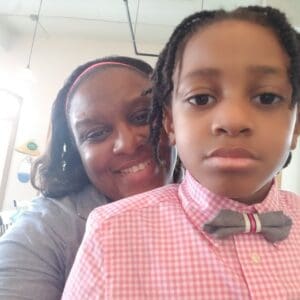Transitioning your young child with disabilities or developmental delays into school can be exciting, yet nerve wracking. You may be asking yourself if your child is prepared to enter this next phase of life, what can you expect, or how can you educate yourself to better advocate for your child? These are all valid questions. Hear from a parent advocate, Corhonda, on her experience transitioning her son Corinth into kindergarten school.
Corinth is a child who, says his mother, is “full of life and always keeps a positive attitude.” He also happens to have Spina Bifida. “My favorite thing about Corinth is his smile. My son has a smile that will light up the world and he is a people’s person,” said Corhonda, Corinth’s mother. “I’ve never seen a child that wakes up and goes to sleep laughing and smiling.”
The transition into school
Like many parents, Corhonda faced challenges transitioning her son into school and had plenty to learn along the way. Receiving the news that your child has a rare disability can be intimidating. Most parents don’t know where to start and feel overwhelmed trying to figure out the best ways to support their child.
Corinth was enrolled in Louisiana EarlySteps (called Early Intervention in many states), but as he got closer to the age of three, his team held an IEP meeting to discuss his transition into the school system.
How to find the right school
Corhonda was intentional about choosing a school that would fit his needs and had a welcoming environment. Being introduced to a new setting can be difficult for children with disabilities and it’s important to do the research to find the right learning environment for your family. For Corhonda, what was most important was the teacher to student ratio, getting to tour the school before starting, and the schedule the school used to help Corinth get used to being there.
Click to Read Transcript
[Corhonda] When Corinth, well Corinth was first in Early Steps, so he was transitioning into the school system at the age of three.
[Interviewer] Okay. ‘Cause with EarlySteps, they transition and they’re into the school by the third birthday.
[Corhonda] And so we have to have the IEP meeting and during that IEP meeting, we did discuss placement. I was aware that they had a school in East Baton Rouge Parish School System that is primarily children with disabilities and had a small number, and every class was basically a small numbers class, and that’s the school that I selected. And it was because that school was going to allow a schedule where he would, to easily transition him in, so the schedule was first few days he was there for like 30 minutes. Then they increased it to a few hours until we eventually got the point that he was there every day for the entire duration of the day.
Click to Read Transcript
Transcript: [Corhonda] They actually work really well with me. We actually were allowed to tour the building first, because I wanted to see what type of classroom he was going to be in. How many students? They actually allowed him the opportunity to see the building himself, and actually walk around. I think that that’s something that a lot of parents don’t think about, but when you’re transitioning your child into an environment that’s away from you, take that tour, and take the time to constantly go to that environment so that it becomes something comfortable for them. And that’s what I did. And they allowed us to do that.
They actually interacted with him. They allowed him to play with the other kids. They asked me, “What did he like? What didn’t he like?” And at that time, we knew that he was a stickler that did not like the words. “No. Don’t. Stop.”
Corinth’s medical team had been instrumental in guiding Corhonda through the systems and processes to set her son up for success. This team was the ultimate resource for making sure she knew her rights, had the information she needed, and understood how to maneuver through hardships she encountered.
“His developmental behavior doctor was like walking knowledge,” said Corhonda. “He provided a book on what my child was diagnosed with, the next steps, what appointments I needed to schedule, and so much more. When I had questions, the first person I would call was him.”
Click to Read Transcript
[Corhonda] Along with many of my child’s other specialists, they would help if they knew the information. If they didn’t, then they would contact the Department of Health and Hospital and ask the question for me. And that was really wonderful. I don’t know if other parents have that type of relationship with their child’s doctors, but they should. Your child’s doctor actually can tell you, and a lot of the information that I state is also public knowledge. Like, it’s normally on the state’s websites as far as, like, if your child is at this particular age range, this is the standards that they should be reaching or accomplishing.
Corhonda did her due diligence researching the perfect school and thought she’d landed one, but quickly discovered that there is no perfect school. While the curriculum seemed to be a good fit and procedures were in place to set him up for success, Corinth was not thriving in his new school environment. Advocating for her son’s needs was a priority on Corhonda’s long list of to do’s.
Overcoming the hardships
Click to Read Transcript
[Corhonda] So at first, I didn’t know much about the school arena. I knew more about early steps by the time that Corinth matriculated into school, versus knowing about the school system. So the school system was something new to me. So at first, I thought, “Hey, this is easy, this is smooth, this works.” No. That is not how it actually ended up working. I did eventually learn that, Hey, Corinth needed to have a functional behavior assessment. Corinth needs a communication device.” And that information was not something that was given to me during the IEP process. That was something that I myself had to actually do a lot of research on and find out about.
The biggest hurdle was getting a communication device that matched Corinth’s needs. At the time, Corith communicated primarily in sign language because he was non verbal. Weeks later, Corhonda discovered that his teachers did not know how to sign and were not experienced with using Corinth’s device.
This led to difficulties for the teachers and the Corinth. The device had been key in his ability to communicate verbally. After requesting a meeting with the school to rectify the issues that Corhonda and Corinth were experiencing, things quickly took a turn for the better.
Corhonda’s biggest piece of advice: know the proper protocol to get what you need and follow up on your requests. Our piece of advice: use the tools and resources on our website to get ahead of the curve.
Click to Read Transcript
[Corhonda] What’s your favorite song?
[Corinth] Hi.
[Corhonda] Yeah, you told them hi. What’s your, yeah.
[Corhonda] What’s your favorite song? Is it, is it “Let It Go?”
[Corinth] Yeah, “Let It Go.”
[Corhonda] Yes, “Let It Go.”
[Interviewer] That’s a great song. We don’t wanna take too much of his time.
[Corinth] Oh, no!
[Corhonda] Were you gonna tell them see you later?
[Corinth] See you later!
If you are interested in sharing your story, contact Sydni Raymond at sydni.raymond@exceptionallives.org. To read more stories like Corhonda and Corinth, visit our Families and Stories page.



